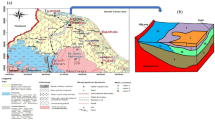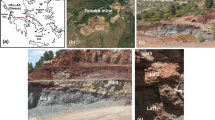Abstract
In this study Cr(tot), Cr(VI), major and trace elements were determined in groundwater of northern sector of the Pollino Massif (southern Italy). The investigated area is characterized by ophiolitic rocks consisting of metabasites, shales and calcschists and fractured serpentinites. Two main hydro-facies were observed, reflecting low temperature water–rock interaction. The Mg-HCO3 hydrofacies is due to the weathering of serpentinites, Ca-HCO3 groundwaters are linked to the interaction with calcschist and metabasites. High Cr(VI) concentrations were detected, exceeding the maximum admissible concentrations by Italian regulation, due to the release of Cr(III) from ophiolitic rocks into water and its oxidation to the hexavalent state. Remediation tests were carried out using two synthetized nanomaterials, Fe(0) and magnetite, characterized by a mean size lower than 50 nm. The experiments were conducted at fixed nanoparticles/Cr(VI) molar ratio and according to previous studies. In addition, the kinetic data were interpreted with a suitable mathematical model.
Similar content being viewed by others
References
Abdul NA, Abdul Talib S, Amir A (2020) Removal kinetics of chromium by nano-magnetite in different environments of groundwater. J Environ Eng 146(2):04019111
Apollaro C, Fuoco I, Brozzo G, De Rosa R (2019) Release and fate of Cr(VI) in the ophiolitic aquifers of Italy: the role of Fe (III) as a potential oxidant of Cr(III) supported by reaction path modelling. Sci Total Environ 660:1459–1471
Apollaro C, Marini L, Critelli T, Barca D, Bloise A, De Rosa R, Liberi F, Miriello D (2011) Investigation of rock-to-water release and fate of major, minor, and trace elements in the metabasalt-serpentinite shallow aquifer of Mt. Reventino (CZ. Italy) by reaction path modeling. Appl Geochem 26:1722–1740
Directive 98/83/EC of 3 November 1998 on the quality of water intended for human consumption. Official Journal L 330. 05/12/1998. 0032-0054
Critelli T, Vespasiano G, Apollaro C, Muto F, Marini L, De Rosa R (2015) Hydrogeochemical study of an ophiolitic aquifer: a case study of Lago (Southern Italy. Calabria). Environ Earth Sci 74:533–543
D. Lgs. 152/2006. “Norme in materia ambientale". Gazzetta Ufficiale n. 88 del 14 aprile 2006 - Supplemento Ordinario n. 96.
Dichicco MC, Laurita S, Paternoster M, Rizzo G, Sinisi R, Mongelli G (2015) Serpentinite carbonation for CO2 sequestration in the southern Apennines: preliminary study. Energy Procedia 76:477–486
Dichicco MC, Castiñeiras P, Galindo Francisco C et al (2018) Genesis of carbonate-rich veins in the serpentinites at the Calabria-Lucania boundary (south Apennines). Rend Online Soc Geol Ital 44:143–149
Dichicco MC, Paternoster M, Rizzo G, Sinisi R (2019) Mineralogical asbestos assessment in the southern Apennines (Italy): a review. Fibers. https://doi.org/10.3390/fib7030024
Di Palma L, Verdone N, Vilardi G (2018) Kinetic modeling of Cr(VI) reduction by nZVI in soil: the influence of organic matter and manganese oxide. Bull Environ Contam Toxicol 101:692–697
Geng B, Jin Z, Li T, Qi X (2009) Kinetics of hexavalent chromium removal from water by chitosan-Fe0 nanoparticles. Chemosphere 75(6):825–830
Kosmulski M (2002) The pH-dependent surface charging and the points of zero charge. J Colloid Interfaces Sci 253(1):77–87
Margiotta S, Mongelli G, Summa V, Paternoster M, Fiore S (2012) Trace element distribution and Cr(VI) speciation in Ca-HCO3 and Mg-HCO3 spring waters from the northern sector of Pollino massif Southern Italy. J Geochem Explor 115:1–12
Margiotta S, Mongelli G, Paternoster M, Sinisi R, Summa V (2014) Seasonal groundwater monitoring for trace-elements distribution and Cr(VI) pollution in an area affected by negligible anthropogenic effects. Fresen Environ Bull 23:1–15
Nollet LM, De Gelder SP (2007) Handbook of water analysis. CRC Press, Boca Raton, p 944
Nordstrom DK (1977) Thermochemical redox equilibria of ZoBell’s solution. Geochim Cosmochim Acta 41:1835–1841
Rizzo G, Sansone MTC, Perri F, Laurita S (2016) Mineralogy and petrology of the metasedimentary rocks from the Frido Unit (southern Apennines. Italy). Period Miner 85:153–168
Rizzo G, Laurita S, Altenberger U (2018) The Timpa delle Murge ophiolitic gabbros. sout Apennines: insights from petrology and geochemistry and consequences to the geodynamic setting. Period Miner 87:5–20
Rizzo G, Canora F, Dichicco MC, Sansone MC (2019) P-T estimates from amphibole and plagioclase pairs in metadolerite dykes of the Frido unit (southern Apennines) during the ocean-floor metamorphism. J Mediterr Earth Sci 11:31–45
Vilardi G, Di Palma L, Verdone N (2019) A physical-based interpretation of mechanism and kinetics of Cr(VI) reduction in aqueous solution by zero-valent iron nanoparticles. Chemosphere 220:590–599
WHO (2016) Guidelines for drinkingwater quality, vol 1. World Health Organization, Geneva
Acknowledgements
These results are part of a larger project (entitled CrITERIA-T3ERA-00004) funded by ERANETMED Joint Call. We are grateful to Dr. M. Dichicco and Dr. S. Laurita for assistance during the samples collection and Prof. A. Argyraki for the constructive comments and suggestions, which helped us to improve this paper.
Author information
Authors and Affiliations
Corresponding author
Additional information
Publisher's Note
Springer Nature remains neutral with regard to jurisdictional claims in published maps and institutional affiliations.
Rights and permissions
About this article
Cite this article
Paternoster, M., Rizzo, G., Sinisi, R. et al. Natural Hexavalent Chromium in the Pollino Massif Groundwater (Southern Apennines, Italy): Occurrence, Geochemistry and Preliminary Remediation Tests by Means of Innovative Adsorbent Nanomaterials. Bull Environ Contam Toxicol 106, 421–427 (2021). https://doi.org/10.1007/s00128-020-02898-7
Received:
Accepted:
Published:
Issue Date:
DOI: https://doi.org/10.1007/s00128-020-02898-7









